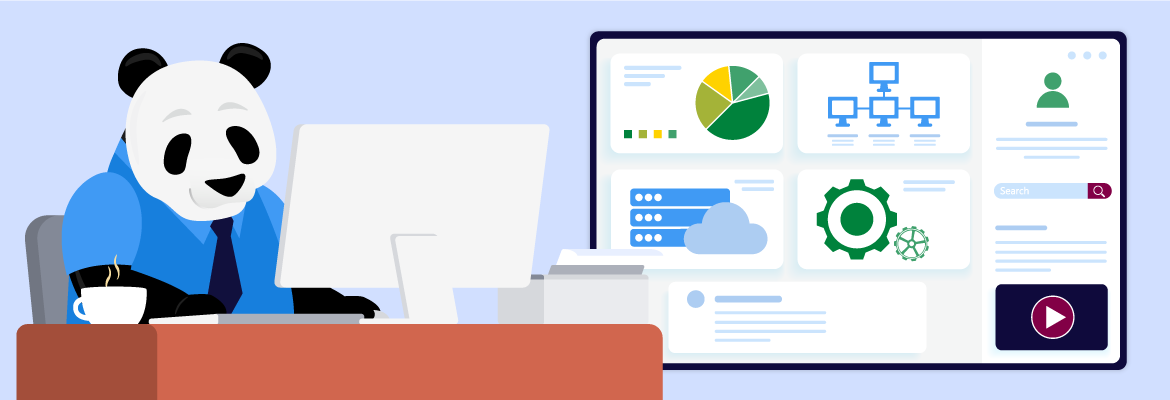Your Guide to Government IT Asset Management

Take Control of Your Assets
A personalized demo is just one click away.
While securely managing IT assets is essential for any organization, it is especially vital for government offices. From local governments to federal agencies, all branches of government rely on IT devices (e.g., laptops, tablets, servers) to conduct daily business and maintain important records. To keep your IT hardware in working order and protect your inventory records, investing in government IT asset management software is essential.
Let's dive into what government IT asset management is, how to choose the right software, and how to build and implement an effective government IT asset management strategy.
What is Government IT Asset Management?
Government IT asset management (ITAM) is the practice of managing your agency's technology assets throughout their lifecycles, from acquisition to disposal. An IT asset can be physical (e.g., servers, desktop computers and laptops, keyboards, monitors, and other hardware) or digital (e.g., software licenses, licensing agreements for public and private clouds, etc.). The purpose of government IT asset management is to gain visibility and control over your entire IT inventory so you can increase security and data accuracy, optimize asset usage, and improve overall efficiency.
To properly manage your IT assets, it's important to implement a comprehensive government ITAM strategy and software that allows you to track the status, location, and utilization of your assets in real time. When you routinely audit and report on your IT inventory, you can optimize device deployment, anticipate upcoming warranty expirations, and forecast future purchasing needs to better manage your government budget.
The Importance of Government IT Asset Management
While a comprehensive government IT asset management program helps you boost efficiency and reduce downtime, there are various financial and operational benefits your office will reap with the right strategy and software in place. Let's take a look at 3 main reasons why government IT asset tracking is so important.
- Optimized IT Device Management: With real-time visibility into the status, location, and condition of your IT hardware, you can better manage preventive maintenance to reduce any downtime or disruptions. By assigning specific IT assets to employees, you can also increase accountability and decrease the potential for loss or theft. Further, when you can see the current utilization of your IT devices, you can optimize their usage and potentially lengthen their lifespan, minimizing your total cost of ownership.
- Better IT Inventory Forecasting and Budgeting: When you have a system to access the full lifecycle of your IT inventory, you can understand the age of your devices, how many times they've been repaired over their lifetime, if they have a remaining warranty, and their current monetary value. With robust data like this, you can better forecast when items need replacing and manage your budget accordingly to avoid unforeseen costs.
- Increased Security and Compliance: By managing your government IT inventory in one centralized place, you'll increase the protection of your important records as compared to using more manual methods like spreadsheets. You can even further trust the security of your IT asset data when you choose a solution with security features such as SOC 2 compliance and single sign-on. Plus, with a detailed record history of your IT assets, you can ensure that you remain compliant with relevant state or federal regulations.
Sectors of Government that Benefit from IT Asset Management
As you read this, you may be wondering, "Is government IT asset management right for my specific office?" The answer is yes! IT asset management software solutions benefit all different types and sizes of government agencies, including:
- Local Government Agencies: Public Works, Municipal and County Court, City Planning and Zoning, Emergency Services and First Responders, etc.
- State Government Agencies: Governor's Office, Health Department, Social Services, Attorney General, etc.
- Federal Government Agencies: Department of Justice, Social Security Administration, Department of Agriculture, Department of Labor, etc.
Choosing the Right Government IT Asset Management Software
No matter your branch of government or number of assets, an IT asset management platform is essential for properly managing your IT hardware. Here are some items to consider as you choose the right government IT asset management software.
- Ease of Use and Customization: The ideal government ITAM solution should be easy to set up and navigate for fast time to value. An intuitive user interface and customizable fields that match the way you already work will allow your team to get up and running quickly.
- Implementation and Ongoing Customer Support: Of course, another crucial aspect of user adoption is proper implementation and customer support. Ensure that your government IT asset management provider offers robust onboarding and ongoing support (ideally available 24/7) so you can easily troubleshoot any issues that may arise.
- Data Security: As a government agency, an ITAM platform's security features are some of the most important factors to consider before signing on. Consider whether a vendor is cloud-based or on-premise, if it has security certifications like SOC 2, StateRAMP, or FedRAMP, and if it offers features like role-based user permissions, single sign-on, and SFTP.
- Integrations: To create one centralized place for your government IT inventory data, you want a platform that integrates into your existing tech stack. Look for solutions that offer integrations with help desks/ticketing systems, network management tools, financial management systems, active directories, and device managers.
- Robust Reporting and Auditing: Your chosen government ITAM software should provide comprehensive reporting and auditing capabilities so you can maintain full visibility into the state of your IT inventory and easily report on it. Consider a solution that allows you to fully customize reports based on your key metrics, and one that lets you create and assign routine audits to your team.
- Mobile App: When it comes to mobile auditing, an easy-to-use mobile app with built-in barcode scanning technology can save you a lot of time and energy. By streamlining your IT inventory audit process with a mobile app, your team will be able to conduct audits on a more frequent basis, improving accountability and increasing your data accuracy at any given time.
Building Your Government IT Asset Management Strategy
Once you have the right government IT asset management software in place, you're ready to build out your ITAM strategy. This should be a document that outlines all your relevant IT assets, stakeholders/chain of command, and, of course, the processes to follow in various scenarios. Here are some best practices to help you create your government IT asset management strategy.
Define Your IT Inventory
As we mentioned at the start of this article, many items can be considered IT assets across your hardware and software. Before you even begin to inventory IT assets to your new platform, it is essential to define what will count as an individual asset versus what might be part of a kit. Kitting smaller items like headphones, keyboards, and mice can help streamline asset deployment processes.
ID and Tag Your IT Assets
Once you've determined what IT hardware and software make up your overall inventory, the next step is to ensure that each item has its own unique ID so it can't be mistaken for another asset of the same model. Ideally, you should also tag each asset with its own barcode label so you can more easily deploy and audit them in the future. Scanning a barcode as opposed to manually entering an item's ID not only saves time but also improves data accuracy. For tips on getting started, consider some common IT asset tagging best practices government agencies use.
Plan for Every Lifecycle Stage
With your government IT inventory clearly defined and labeled, it's time to document the various processes your team should follow at the different lifecycle stages of your IT assets. These lifecycle stages include:
- Procurement: Budgeting for and purchasing your IT assets
- IT Asset Identification and Registration: Capturing asset details like type, serial number, specifications, purchase date, warranty, etc.
- IT Asset Deployment: Distributing IT assets to their intended users or departments (this can include asset tagging, assignment, configuration, installation, etc.)
- Routine Tracking and Monitoring: Regularly reporting on the status of your assets and conducting audits to ensure data remains accurate
- Preventive Maintenance and Support: Tracking routine maintenance needs as well as warranty and support service contract expirations
- IT Asset Disposition (ITAD): Decommissioning IT assets at the end of their life and recycling or disposing of them safely
- Replacement: Replacing IT assets that have been retired or are no longer meeting the organization's needs in terms of cost-effectiveness and technological advancements
Once your government ITAM strategy is clearly documented, make sure to hold training sessions for all the end-users of your asset management software. This will not only help user adoption of your newly implemented solution but will also ensure that people are following the correct processes.
Getting Started with Government IT Asset Management
Whether you're looking to make the switch from Excel spreadsheets or are building a government IT asset management program from scratch, the right strategy and software are key to your success. As you begin to work on your government ITAM plan, check out these additional best practices:
- IT Asset Management Best Practices
- How a State Government Agency Revolutionized its IT Asset Management
When you're ready to put your government ITAM plan into place, Asset Panda is here to help. Request your demo today to see our comprehensive government asset tracking software in action.
Take Control of Your Assets
A personalized demo is just one click away.
Related News & Press

Learn more from an Asset Panda expert
Get a FREE consultation with an asset tracking expert to find out how you can transform your asset tracking.
Contact our Sales Team at (888) 928-6112


